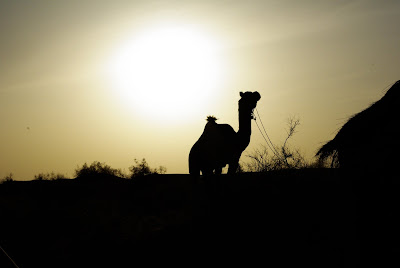





You need to be seated because you just won’t believe what you are about to read about and see. We all agreed that this is absolutely the craziest thing we have ever seen and been standing in the middle of. Just TRY to wrap your head around this one!
Front of The Rat Temple
Our last stop today will be at the Karni Mata Hindu Temple, also known as the Rat Temple. The temple is located a short 30km drive south from Bikaner in the small town of Deshnok.
The legend of Karni Mata goes like this –
In the 14th century, Goddess Karni is said to have lived and performed many miracles during her existence (she was a real person). Karni Mata was a mystic, who led a virtuous life committed to the service of the poor and the oppressed of all communities. The goddess is said to have laid the foundation of Deshnok. As per the stories, once when her youngest son drowned, Goddess Karni asked Yama (the god of death) to bring him back to life. Lord Yama replied that he could not return her son’s life. Thus, Karni Mata, being an incarnation of Goddess Durga (the invincible one, one who can redeem in situations of utmost distress), restored the life of her son. At this point of time, she announced that her family members would die no longer; in fact, they would incarnate in the form of rats (kabas) and ultimately, these rats would come back as members of her family. In Deshnok, there are around 600 families that assert to be the descendants of Karni Mata.
The temple at Deshnok was built in the 15th century. It houses around 5,000 rats that are fed, protected and worshipped. Many holes can be seen in the courtyard of this temple. In the vicinity of these holes, one can see rats engaged in different activities. The rats can be seen here eating from huge metal bowls of milk, sweets and grains. To make the holy rats safe, wires and grills are sited over the courtyard to avoid the birds of prey and other animals getting inside.
It is regarded as good luck if a rat runs over your foot (this happened to me twice!) and it is considered promising and fruitful if you spot a rare white rat. As with all Hindu temples, visitors must remove their shoes before entering, which could make you cringe if you are nervous about walking around with a bunch of rats at your feet. The temple floor is not filthy, but you do run the risk of stepping on a few droppings as you walk around the temple.
Here are the photos and movies……….
Here we are with our driver, Krpal, just outside the temple gates. He is giving us the history of the temple and trying to prepare us for what we are about to see.
Once inside the courtyard of the temple, we found these rats drinking from a bowl of milk.
You have to admit they are pretty cute.
Hey mom, you know I've done some pretty crazy things in my life, right? After seeing this, maybe now you won't think that bunji jumping in New Zealand was really that crazy after all!








NRCC Camel Breeding Farm
The desert dwellers of Rajasthan could not survive without their camels. In the sandy, inhospitable expanse of the Thar Desert, it is their only means of transport, their beast of burden, as well as an important source of nourishment (camels' milk, slightly salty in taste, is drunk throughout Rajasthan's desert). The hardy camel demands little in return. It can do without food and water for up to a month in winter, and a week in the summer, tanking up on 70 liters of water at one go! The Rajasthani’s affection for his camel is evident in all of the desert fairs, where camels are celebrated.

The Indian Council of Agriculture Research (ICAR) established the National Research Center on Camel (NRCC) in Bikaner in 1984 to research and breed the finest camels in the world. The NRCC Camel Breeding Farm in Bikaner is managed by the government and is the largest in Asia. The center works with the three varieties of camel found here: Bikaneri, Jaisalmeri and Gujarati. They have developed an elite herd of camels at the facility for strength and endurance. They supply the army with camels whose cavalry regiments patrol the desert borders with Pakistan on camel back. Since we are getting ready to ride off into the Thar Desert on camels ourselves, we figured it would be good for us to visit this farm to learn more about the animals that will carry us into and, we hope, out of the desert. :o) We braved the near 100-degree temperature to go out and visit the farm (remember, we ARE in the desert!).
As we were walking up to the farm, the female camels and some of their young were coming in from grazing and on their way in to the corral. It was a magnificent sight to see them all walking in line as they came in. They move with such grace and ease considering their size and odd shape. I will have to let you know how much that 'grace and ease' translates to my body after I have been on one all day tomorrow! :o)




